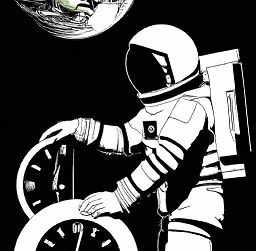
 David Mitlyng for Xairos
David Mitlyng for Xairos
It's Lunar Time!
Over fifty years since humans last visited the moon, Space Race part II is underway (see below).
At stake: claiming the high value polar real estate where there is ice, sun, and a view of Earth.
But first you need a lunar GPS to guide the rovers; NASA and European Space Agency are on the case.
But what time do you use on the moon?
The obvious choice: the same as Earth time.
Unfortunately, general relativity means that a "lunar clock would gain about 56 microseconds over 24 hours" compared to an Earth clock.
And regular synchronization through multiple hops across 240,000 miles is a challenge.
The other option is an independent lunar time based on master clocks on the moon or the lunar GPS.
This means that the Earth and moon clocks will diverge so a lunar resident will have a slightly different birthday than their Earth-bound twin.
And even local clocks would vary based on location due to the moon's lumpy gravitational field.
In any case, a lunar time synchronization network is needed.
Last Week's Theme: The Last 500 Feet
- We recently kicked off a Start Engine raise - check out our campaign page here and own your own piece of Xairos!
- Our next Investor Update Session is set for Thursday, February 9, at 6 pm ET. You can join us at this Zoom link or add to your Google, Outlook, or Yahoo calendar.
- Team is back from an overseas trip working on new business and partnerships.
- Received notice that our "Quantum Secure Network Clock Synchronization" US patent will be granted soon, and the Europe, Japan, and Korea patents were filed.
- Preparing for upcoming Board and Advisory Meetings.
- Last month the General Accounting Office (GAO) released their report “GPS Disruptions: DOT Could Improve Efforts to Identify Interference Incidents and Strengthen Resilience" that "found that DOT's process for identifying incidents doesn't produce accurate or complete information and isn't documented.”
- A recently launched Chinese satellite named Shijian 23 has “apparently released an object into orbit alongside it” that could be “used together with the parent satellite for on-orbit testing.” May be nothing, but it is strange “that initial reports…listed two additional satellites Shiyan 22A and 22B, as payloads aboard the launch. An updated story from Xinhua a day later omitted reference to the latter pair.”
- How do you protect vulnerable satellites from anti-satellite missiles or other on-orbit threats? With a “satellite bodyguard.”
- US Congress and the FCC announced an Energy & Commerce Committee hearing focused on “ensuring America continues to lead in the burgeoning satellite communications industry…The satellite industry is growing at a record pace, but here on the ground our regulatory frameworks for licensing have not kept up.”
- The NASA Psyche asteroid probe includes a Deep Space Optical Communications (DSOC) payload that will be NASA’s “first demonstration of optical communications beyond the Earth-Moon system.”
- Photonics West and Quantum West, January 28 - February 2, San Francisco, CA
- Workshop on Synchronization and Timing Systems, March 13 - 16, Vancouver, Canada
- Satellite 2023, March 13 - 16, Washington DC
- Space Symposium, April 17 - 20, Colorado Springs, CO
There is a new space race underway between the US, Europe, and China for the moon.
NASA recently completed the Artemis mission with plans to get to the moon “as early as 2025 or 2026."
Europe, meanwhile, is planning a lunar lander “capable of routinely dispatching science payloads and cargo to the Moon throughout the 2030s.”
China also laid out their ambitious lunar exploration plans that includes the:
- Chang'e 3 mission launched in 2013 that includes the Yutu rover.
- Queqiao relay satellite launched in 2018.
- Chang'e 4 mission launched in 2019 that includes the Yutu 2 rover that recently released some impressive images and a number of discoveries and has been tracked by NASA's Lunar Reconnaissance Orbiter (LRO).
- Chang'e 5 mission launched in 2020 which collected lunar samples and delivered them to Earth.
- Queqiao-2 lunar communications relay satellite planned for 2024.
- Chang'e 6 mission planned for late 2024 that “will attempt to collect samples from the far side of the moon, within the South Pole-Aitken Basin.”
- Chang'e 7 mission planned for 2026, to include an “orbiter, lander, rover and a small, flying detector that can move into shadowed craters to hunt for evidence of water ice,” in the southern pole and far side of the moon. It will also carry a second, smaller rover for the United Arab Emirates.
- Chang'e 8 mission planned for 2028 to “test technologies for 3D printing and for using local resources.”
- International Lunar Research Station (ILRS) planned for the 2030s that “will initially be robotic but is intended to be capable of hosting astronauts for long-term stays from around 2035.”
Also in the mix: commercial lunar exploration startups like ispace, Astrobotic Technology, Intuitive Machines, and SpaceIL.
To learn more, please email us or schedule a meeting here.

